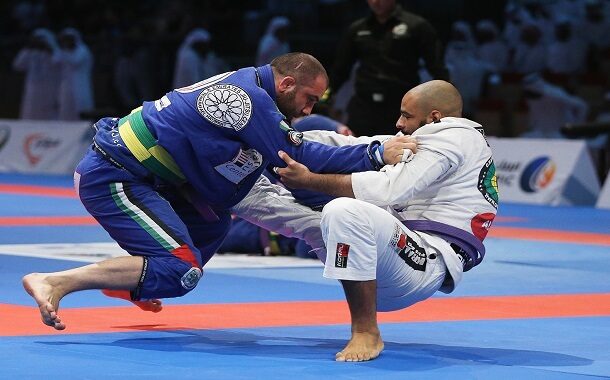How Much Does Jiu Jitsu Cost?
Last Updated on February 8, 2024
Written by CPA Alec Pow | Content Reviewed by ![]() CFA Alexander Popinker
CFA Alexander Popinker
Jiu jitsu, also known as Brazilian jiu jitsu (BJJ), has exploded in popularity in recent years as both a martial art and a fitness activity. But like any hobby, jiu jitsu requires an investment of both time and money.
So what’s the true cost of getting started and staying committed to BJJ training? Here’s a detailed breakdown of the common expenses you can expect as a jiu jitsu practitioner.
How Much Does Jiu Jitsu Cost?
The foundation of ongoing jiu jitsu practice lies in your gym membership dues and the structure of classes/training. What’s the typical pricing and commitment?
Monthly Membership Fees and Class Packages
Most BJJ gyms offer monthly memberships or class packages. Common pricing tiers:
- Unlimited classes: $120-250 per month
- 8-12 classes per month: $100-150 per month
- 4-6 classes per month: $80-120 per month
- Drop-in single classes: $20-40 per class
As you train more seriously, unlimited memberships provide the best value. But a limited package may suit beginners sampling just 1-2 classes a week.
Enrollment Fees and Trial Jiu-Jitsu Class Options
New student onboarding costs include:
- Enrollment fee: $50-150 one-time payment
- Intro class package: $29-99 for 1-4 week trial period
Reputable gyms often let you try a fundamentals program before committing to ongoing payments. Make sure to ask about intro offers and free trial classes.
Jiu Jitsu Overview
Brazilian Jiu-jitsu is a grappling-focused martial art that teaches useful self-defense techniques and skills. It promotes physical fitness, personal development, and practical street defense.
Jiu jitsu training involves learning takedowns, joint locks, chokes, throws, and unarmed combat tactics. Classes typically consist of technique drills, live sparring called “rolling”, and strength/cardio conditioning.
The gentle art has grown from its Brazilian roots to have academies worldwide with millions of students. The fitness community loves jiu jitsu for its full-body workout and mind-body discipline.
Meanwhile, security and law enforcement personnel train BJJ for its real-world applicability. Jiu jitsu provides an exciting way to get in shape and gain confidence in self-protection abilities.
Additional Expenses in Jiu Jitsu Training
Enrolling in jiu jitsu means more than just paying your monthly gym membership dues. There are other common expenses that quickly add up.
Cost of Uniforms (Gi) and Other Necessary Gear
To train BJJ, you’ll need to purchase a sturdy jiu jitsu uniform called a gi. Decent starter gis range from $75 to $150. You’ll eventually need more gis as you progress through the belts and wear out your uniforms with regular use. Expect to budget $100-300 per year on gis.
You’ll also need training gear like rash guards ($25-60) to wear under the gi, mouthguards ($15-25) for sparring safety, a gym bag ($30-60), and so on. Altogether your startup gear costs can easily total $200-400.
Belt Promotion Fees and Private Lesson Rates
As you advance in jiu jitsu and test for new belt ranks, you’ll have to pay belt promotion fees typically around $50-100. Although some gyms include promotion tests in the membership costs, others charge separately.
Many students also invest in private lessons with instructors, ranging from $50-150 per hour. Privates let you learn faster with personalized coaching. Between test fees and private training, anticipate $500+ per year in these added instruction expenses.
Costs Associated with Advanced Gym Training
Once you’re hooked on jiu jitsu, you’ll likely want to take your training and skills to higher levels by participating in camps, seminars, and competitions. These advanced training activities often require special memberships and travel expenses.
Seminar and Workshop Fees
Top jiu jitsu camps and seminars run by celebrity BJJ black belts can cost hundreds of dollars for a weekend workshop. Even local seminars are typically $75-150 for a few hours of instruction. Expect to spend $200-500 per year if you attend just a few seminars.
You might also like our articles on the cost of Kickboxing classes, boxing lessons, or Taekwondo classes.
Competition Registration and Travel Expenses
Competing in jiu jitsu introduces registration fees, travel costs, and time off work. Local tournament signup fees are usually $60-100. But major competitions like the IBJJF Worlds can charge $200+. Factor in travel and you’re looking at thousands per year in competition expenses.
Insurance and Other Overlooked Costs of BJJ
Besides the obvious expenses, some additional fees may catch you by surprise.
Insurance for Martial Arts Practice
BJJ carries an inherent risk of minor injuries like mat burn or strained joints from intense grappling drills. Reputable gyms provide insurance included in membership fees, but it’s limited coverage. For better protection in case of serious accident, supplemental policies run $100-300 per year.
Facility Maintenance and Access Fees
 Like all fitness facilities, jiu jitsu gyms require regular equipment maintenance and repairs which they’ll pass some costs onto members through occasional “gym improvement fees” of $25-50 per year or one-time assessments. Some also charge keycard access fees around $20 per month for 24/7 building entry.
Like all fitness facilities, jiu jitsu gyms require regular equipment maintenance and repairs which they’ll pass some costs onto members through occasional “gym improvement fees” of $25-50 per year or one-time assessments. Some also charge keycard access fees around $20 per month for 24/7 building entry.
Online Jiu Jitsu Training Costs
Can you save money learning BJJ through online training programs compared to in-person gym fees? Possibly, but experts advise against relying solely on virtual instruction as a beginner.
- Online training platforms: $15-50 per month for access to video instruction. Great supplemental training for more advanced students.
- Online coaching: $100-300 per month for personalized virtual lessons via video chat. Provides occasional feedback but lacks real-time corrections.
- In-person training: $100-250 per month remains ideal for hands-on practice, live rolling, and instructor adjustments as you learn proper technique.
While online training seems cheaper, the lack of mat time and coaching makes it harder to progress quickly as a beginner. After one year, typical students pay $1,200-$3,000 for gym access versus $180-$600 for online-only content.
Tips for Managing Jiu Jitsu Training Expenses
With savvy planning, you can keep jiu jitsu training costs under control:
- Buy used gis and gear to save 50% or more
- Split private lesson fees training with a partner
- Attend free open mat sessions for extra practice
- Compete in local tournaments instead of expensive nationals
- Take advantage of family discounts if training with relatives
- Comparison shop membership rates between gyms
- Consider part-time college classes for reduced instruction fees
Shop sales and buy last season’s gear. Hand-wash and carefully maintain your gis to maximize lifespan. Overall, focus on value, not low cost – an experienced instructor is worth the premium.
Conclusion
Like any deep expertise, excelling in jiu jitsu demands time and money. Training several times per week, you can expect to invest $100-400 monthly in gym fees, gear replacements, and continued instruction. Serious competition and camps add thousands in expenses annually.
However, the personal rewards of improved fitness, self-defense skills, and self-confidence make jiu jitsu worthwhile for many. With smart budgeting and comparison shopping, it’s possible to keep jiu jitsu training costs reasonable. Weigh the value carefully, and enjoy your journey in the gentle art!
Frequently Asked Questions
How many times a week do you go to jiu-jitsu?
Experts recommend training jiu jitsu 2-5 times per week to build skills efficiently as a beginner. Here are typical training frequencies:
- 2 times per week: Minimum for retaining skills. Best for people with limited time.
- 3 times per week: Allows good progression for hobbyists. The most common schedule.
- 4-5 times per week: Accelerates learning and improves conditioning. Great for competitors.
The more you train, the faster your abilities improve. But even twice a week provides benefits. Make sure to balance jiu jitsu sessions with strength training and rest days for full development. Consistency over time brings the greatest gains.
Can you get paid to do jiu-jitsu?
Yes, jiu jitsu can become a paid career through competitive success, instructor roles, and industry work. Some ways to earn income in BJJ:
- Competing professionally with sponsorships and cash prizes
- Teaching classes and privates as a gym instructor
- Opening your own jiu jitsu school or academy
- Becoming a brand ambassador or sponsored content creator for jiu jitsu companies
- Working for jiu jitsu organizations and events in marketing/management
- Producing educational jiu jitsu instructionals to sell online
- Coaching jiu jitsu competitors and cultivating champions
However, less than 1% of jiu jitsu athletes make it a full-time job. For most people, BJJ remains a hobby supported by a primary career. With dedication and business savvy though, it’s possible to monetize your jiu jitsu passion.
Should I do BJJ or Krav Maga?
BJJ and Krav Maga have different strengths as martial arts. Here’s how to choose which is better for your goals:
Jiu Jitsu Pros:
- Emphasizes sparring against full resistance
- Teaches superb ground fighting skills
- Develops core strength, flexibility, and endurance
- Promotes patience, discipline, and strategy
Krav Maga Pros:
- Focuses on real-world self defense tactics
- Striking and weapons training
- Simple, easy to learn techniques
- Built for street combat scenarios
For sport grappling and fitness, BJJ is superior. For pure self defense, Krav Maga has the edge. Try intro classes in both to see which you enjoy. An ideal solution is cross-training BJJ for ground skills and Krav for stand-up.


Leave a Reply
Want to join the discussion?Feel free to contribute!